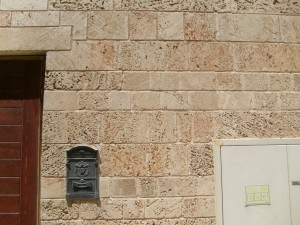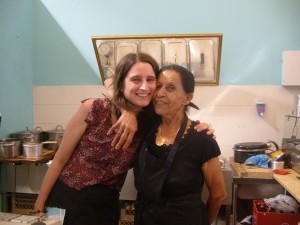A lovely story showing how the Arab city of Jaffa was stolen from its original inhabitants, who were driven out at the point of a gun. As Naomi, a poet and fellow member of Brighton PSC says, the myth of the Jews being ‘driven into the sea’ has some basis in fact – it was Jaffa’s Arabs who were driven onto boats, some drowing, as Zionist terrorists fired bombs and instilled terror in a defenceless population. Just 4,000 remained out of 70,000 people – something Ilan Pappe documents in his Ethnic Cleansing of Palestine. The photographs of what remains of Arab Jaffa are delightful and give a glimpse of what life must have been like before Zionist colonisation.
Tony Greenstein
Yaffa Rocks


 Posted on May 12, 2012 by nfoyle
Posted on May 12, 2012 by nfoyle
First day in Israel-Palestine, and a stop in Tel Aviv enroute to Jerusalem, Jenin and Ramallah. But what to do in a city you are boycotting? Protest, of course. Today I joined Arab and Jewish Israeli activists demonstrating in Yaffa – AKA Jaffa and Yafo, the old Arab town now subsumed by Tel Aviv – in support of the mass hunger strike of over 1600 Palestinian prisoners. The prisoners are protesting the practice of Administrative Detention – indefinite imprisonment without charge or trial – the use of solitary confinement and the denial of family visits. Today marked the 75th day of hunger for two men, Thaer Halahleh and Bilal Diab, who are now close to death. The strike is reaching crisis point, and could trigger the eruption of the third intifada. Not that you would guess that from Tel Aviv’s crowded beaches, juice bars and night clubs.
The city is Israel’s pleasure centre, a kind of LA mixed with Istanbul, its modern skyline overshadowing crumbling archways, faded Ottoman-era buildings, punks in full regalia, and people smoking narghile on the seafront lawns. It boasts many a museum and theatre, but these are state-funded boycott targets. Besides, why pay to be told lies? I’m here because I wanted to see Yaffa, from which 66,000 Palestinians were expelled in 1948, leaving only 4000 original residents. Journalist Jonathan Cook cites Ilan Pappe’s account of Israeli soliders shooting over the heads of the Yaffa Arabs to force them to board fishing boats bound for Gaza. The prevalence of the phrase ‘They want to drive us into sea’ in Israeli hysteria about Palestine suggests that projection of the shadow is a political as well as psychological phenomenon. Since what the city information boards call ‘the liberation’ of Yaffa – in fact, the theft of Arab homes – Tel Aviv has turned the port area of the old city into an ‘artists’ quarter’, home also to some impressive churches (and if you want to complain to the Pope about child sex abuse or his policy on condoms, the Vatican Embassy accepts letters).
But a moment of whimsey aside, walking the quarter is a joyless experience. Here the limestone buildings are scraped clean of all traces of their history. After my time in Cairo, Diyarbakir and Sanliurfa, exploring these narrow lanes was like meeting an old friend who has microdermabraised and botoxed her face beyond all expression of human feeling.
South of the port area is the Arab neighbourhood of Ajami, where the 4000 remaining Arabs where confined for two years after the ‘liberation’. Here, my guidebook tells me, Ottoman-era villas rub shoulders with tiny fisherman houses. The picaresque desription masks the war that still festers in Yaffa. The villas have been renovated by wealthy Jewish Israelis, while the Palestinians – now numbering around 18,000 – are being driven out of their ancestral homes by Byzantine planning regulations that inflict huge fines for making any unauthorised alteration to a property, however necessary it may be. For now, the Yaffa Arabs appear to be clinging on. In Ajami I saw laundry hanging out to dry, women in headscarves pushing prams, and the Palestinian colours quietly hung in the side window of a villa festooned – as are so many Tel Aviv cars and buildings – with Israeli flags. (As for the stallion tethered to a tree, I’m afraid I can’t tell you his pedigree.)

No wonder the protests mount. The demonstration today was held at Clock Square, a traffic island opposite the old Ottoman govenor’s residence. The protestors lined both sides in blindfolds and bound wrists, attracting gestures of abuse and support from passing motorists, and while the police circled for ninety minutes, they didn’t interfere. In Israel, I learned, a protest is illegal if three conditions are met: there are more than 50 people; speeches are made (as opposed to chanting); and a procession begins. I was also told the solidarity street theatre occurs every day at 6pm, and that this size of demonstration hasn’t been seen for some time in Tel Aviv. Activists today drove in from Jerusalem, and went on to Haifa, two hours away.
Having only one day here, I remained in Jaffa, and stumbled on the magnificent Almatbach – according to the signboard, a Arab women’s restaurant, and, as the menu elaborated, ‘a local project involving the old women of Yaffo and their simple yet incredible dishes.’ Two of the Arab activists were eating there, so I ventured in, through two wide-open fifteen feet tall wooden doors, to sit beside the open kitchen beneath a spidery chandelier Louise Bourgeous would have been proud of. There I was served four dishes of pickled beets and cabbage, an overflowing plate of rice, fish, hummous, olives and fried portobello mushrooms, with a glass of rather nice red wine, all followed by quite the best spice cookie I’ve had in a long while. My extremely limited Arabic was lavishly praised, and when I asked if I could take a photo of the Smokin’ Old Mama in charge of the kitchen, the manageress insisted on snapping us together. ‘Habibti, habibti’ the Yaffa Doyenne called me – understanding this as ‘sweetie’, I went on my way feeling wonderfully welcomed to Palestine. And hoping that my full stomach, today and in the future, would give me the energy to do as much as I can in support of Palestinian rights.

